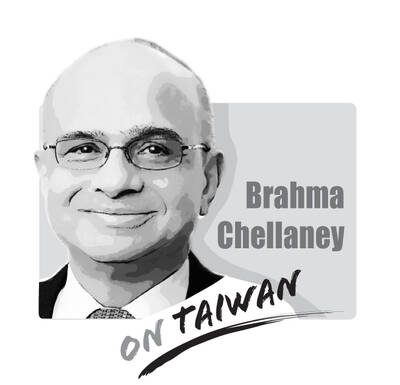A closer look at many potential conflict zones in East and South Asia reveals an alarming trend of transience and instability. This is particularly true when a nuclear and militaristic North Korea looms, threatening its neighbors and beyond.
We are witnessing what British journalist Gideon Rachman calls a troublesome process of “Easternization,” a dramatic shift of power and wealth from the West to Asia in the early 21st century.
At a time when US President Donald Trump seems unwilling to promote international trade and defend a global security framework built on US-led alliances, China and India are moving up the global hierarchy of superpowers.
They regard one another as geopolitical competitors, with each utilizing diplomatic channels and military tactics to counter the other.
Expansionism is deeply ingrained in the mindsets of Chinese and Indian nation-states, prompting them to advance neoliberal capitalism against economic protectionism, thereby giving a new twist to the forces of globalization and nationalism.
The latest Sino-Indian territorial rivalries show that the two countries are victims of their history of nation-building. Overturning the other’s growing power has become the major geopolitical objective for China and India. By drawing rigid national boundaries in parts of the Himalaya borderlands, they are prepared to challenge each other’s backyard.
While China considers South Asia to be a legitimate area to flex its muscle, India views China as an external intruder.
Troubled by India’s support of the creation of the Dalai Lama’s exiled government in Dharamsala, the ascension of Sikkim to India, and the Indian dominant influence in Bhutan, China has been arming Pakistan to contain India.
In response to the perceived Chinese threat, India has pursued security collaborations with Taiwan, Japan, Vietnam and Russia.
The open, rules-based international order that the US developed is in decline.
The new geopolitical landscape presents two pressing challenges to China and India.
First, given their enormous national economies, it is not in their interests to engage in border conflicts. The months-long Doklam border stand-off has revealed considerable political, economic and cultural insecurities on both sides.
Without an effective international mechanism to resolve the overlapping claims in the Himalayas, the border crisis has exemplified the conflicting understanding between China and India over control of continental space, as well as over jurisdiction related to disputes in these frontiers.
Second, the Doklam incident has become a new front line for Sino-Indian tensions. The Chinese and Indian ultra-nationalists, within and without their governments, have reacted with fury and resentment. Driven by a narrow view of territorial sovereignty, they fueled a negative, almost xenophobic nationalism and see everything as a zero-sum game.
Projecting themselves publicly as charismatic and visionary leaders, Chinese President Xi Jinping (習近平) and Indian Prime Minister Narendra Modi thrive on the cult of a nationalist strongman and proclaim to defend national sovereignty at all costs.
Even though they are cynical toward such irrational sentiments in private, the seduction of domestic propaganda and nationalistic rhetoric could restrict their freedom of action to end the crisis.
If they fail to live up to this image of tough statesmen, they will find it difficult to appeal to local nationalists and win the internal power struggle with their domestic opponents.
Joseph Tse-hei Lee is professor of history at Pace University in New York City.

Taiwan stands at the epicenter of a seismic shift that will determine the Indo-Pacific’s future security architecture. Whether deterrence prevails or collapses will reverberate far beyond the Taiwan Strait, fundamentally reshaping global power dynamics. The stakes could not be higher. Today, Taipei confronts an unprecedented convergence of threats from an increasingly muscular China that has intensified its multidimensional pressure campaign. Beijing’s strategy is comprehensive: military intimidation, diplomatic isolation, economic coercion, and sophisticated influence operations designed to fracture Taiwan’s democratic society from within. This challenge is magnified by Taiwan’s internal political divisions, which extend to fundamental questions about the island’s identity and future
The narrative surrounding Indian Prime Minister Narendra Modi’s attendance at last week’s Shanghai Cooperation Organization (SCO) summit — where he held hands with Russian President Vladimir Putin and chatted amiably with Chinese President Xi Jinping (習近平) — was widely framed as a signal of Modi distancing himself from the US and edging closer to regional autocrats. It was depicted as Modi reacting to the levying of high US tariffs, burying the hatchet over border disputes with China, and heralding less engagement with the Quadrilateral Security dialogue (Quad) composed of the US, India, Japan and Australia. With Modi in China for the
The Chinese Nationalist Party (KMT) has postponed its chairperson candidate registration for two weeks, and so far, nine people have announced their intention to run for chairperson, the most on record, with more expected to announce their campaign in the final days. On the evening of Aug. 23, shortly after seven KMT lawmakers survived recall votes, KMT Chairman Eric Chu (朱立倫) announced he would step down and urged Taichung Mayor Lu Shiow-yen (盧秀燕) to step in and lead the party back to power. Lu immediately ruled herself out the following day, leaving the subject in question. In the days that followed, several
The Jamestown Foundation last week published an article exposing Beijing’s oil rigs and other potential dual-use platforms in waters near Pratas Island (Dongsha Island, 東沙島). China’s activities there resembled what they did in the East China Sea, inside the exclusive economic zones of Japan and South Korea, as well as with other South China Sea claimants. However, the most surprising element of the report was that the authors’ government contacts and Jamestown’s own evinced little awareness of China’s activities. That Beijing’s testing of Taiwanese (and its allies) situational awareness seemingly went unnoticed strongly suggests the need for more intelligence. Taiwan’s naval